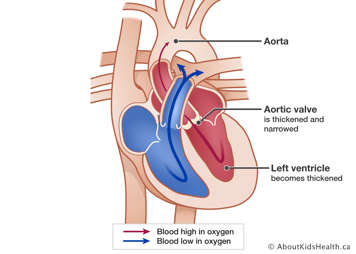What is aortic stenosis?
Aortic stenosis is a heart condition that causes obstructed blood flow between the aorta and the left ventricle. Stenosis means narrowing or blockage of a valve or blood vessel that reduces blood flow. In aortic stenosis, the aortic valve is thickened and narrowed. It does not open completely and obstructs blood flow to the aorta.
The images below compare a normal heart to a heart with aortic stenosis.


The aortic valve has three leaflets that function like a one-way door, allowing blood to flow forward into the aorta, but not backward into the left ventricle. With aortic stenosis, the aortic valve is unable to open completely, so the blood flowing from the left ventricle to the aorta is constricted, or squeezed.
- If the constriction occurs at the valve, it is called valvar aortic stenosis.
- If the constriction occurs above the valve, it is called supravalvular stenosis.
- If it is below the valve, it is called subaortic stenosis.
Aortic stenosis occurs in 3% to 6% of patients with heart defects.
The constriction means that the left ventricle has to increase pressure to pump the blood through the opening. As a result, the wall of the ventricle thickens.
What are the symptoms of aortic stenosis?
In most cases, children do not have symptoms. In severe cases, however, this condition can lead to a variety of symptoms, like chest pain, dizziness or fainting, and heart failure, particularly in younger infants. A heart murmur is the most common sign of this defect.
An electrocardiogram and echocardiogram are used to make a diagnosis. In mild cases, children with aortic stenosis do not need treatment. However, they do need to receive repeat medical checkups with echocardiograms because sometimes the narrowing gets worse as the child grows older.
How is aortic stenosis treated?
Cardiac catheterization is often used to treat aortic stenosis. The narrowed valve is stretched open through a procedure called balloon dilation valvuloplasty. This may relieve the narrowing, but the valve leaflets may remain stiff and are unable to close properly. This means there may be leakage of blood backwards through the valve, called regurgitation.
Sometimes open heart surgery to cut open the leaflets of the valve so they open better is needed. This is called a surgical valvotomy. Later, surgery may be needed to replace the valve if it is very small or leaky. This is called aortic valve replacement.
What is the long-term outlook for children with aortic stenosis?
Children with aortic stenosis will need to be seen by a cardiologist for their whole lives, since the condition can worsen over time, even after surgery.
